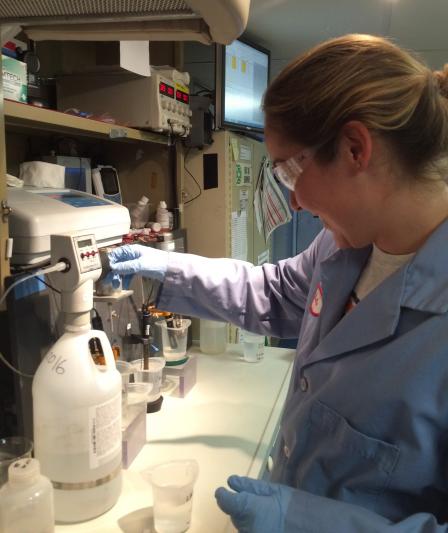Great Lakes Water Quality Monitoring Program Board Chemistry
Board chemistry procedures are completed on the R/V Lake Guardian directly after the water samples are collected from the Rosette water sampler at each sampling station on the lakes. The pH, alkalinity, conductivity and turbidity are determined for each collected water sample depth. Hardness is also measured for some water samples.
pH is a measure of the hydrogen ion (H+) concentration in the water, which is commonly used to determine if the water is more acidic (higher H+ concentration, associated with a lower number on the pH scale) or basic (higher OH- concentration, associated with a higher number on the pH scale). pH controls many chemical and biological processes that occur in the lakes, so monitoring pH is important for understanding lake-wide processes and the aquatic organism health.
Alkalinity is a measure of the buffering capacity of the water, which is the water's ability to resist changes to pH when an acid is added. Alkalinity provides information about the ecosystem's ability to remain in a steady-state during pH fluctuations.
Conductivity![]() ConductivityA measure of the ability of a solution to carry an electrical current. in water is used as a measurement of the concentration of ion
ConductivityA measure of the ability of a solution to carry an electrical current. in water is used as a measurement of the concentration of ion![]() ionAn electrically charged atom or group of atoms.s in the water. The higher the ion concentration, the higher the conductivity of the water, which is the ability of the water to conduct electricity. Salts are an example of an ion, which is an atom or molecule with a net charge. Since water temperature can influence conductivity, GLNPO measures specific conductance, which is the conductivity temperature-corrected for 25o Celsius.
ionAn electrically charged atom or group of atoms.s in the water. The higher the ion concentration, the higher the conductivity of the water, which is the ability of the water to conduct electricity. Salts are an example of an ion, which is an atom or molecule with a net charge. Since water temperature can influence conductivity, GLNPO measures specific conductance, which is the conductivity temperature-corrected for 25o Celsius.
Turbidity is a measure of water clarity. When light is shown through a water sample, turbidity![]() turbidityThe degree of clearness of a liquid or the lack of visual clarity of a liquid. It is defined by the measure of light scattering due to the presence of particles suspended in the liquid. Turbidity is similar to opacity for particles suspended in the gas phase. is the amount of light scattered by the material in the water. When there is more material in the water, such as organic matter or sediment, then there is higher light scattering, which is measured as higher turbidity. Higher turbidity indicates more material floating in the water, which affects water quality and other processes in the water column. It also affects light penetration in the water column, limiting the depths of organisms that require sunlight for photosynthesis
turbidityThe degree of clearness of a liquid or the lack of visual clarity of a liquid. It is defined by the measure of light scattering due to the presence of particles suspended in the liquid. Turbidity is similar to opacity for particles suspended in the gas phase. is the amount of light scattered by the material in the water. When there is more material in the water, such as organic matter or sediment, then there is higher light scattering, which is measured as higher turbidity. Higher turbidity indicates more material floating in the water, which affects water quality and other processes in the water column. It also affects light penetration in the water column, limiting the depths of organisms that require sunlight for photosynthesis![]() photosynthesisThe process by which plants convert carbon dioxide and water into carbohydrates and oxygen. These carbohydrates are used as energy by the plants or by organisms that consume the plants. Photosynthesis is also called primary production..
photosynthesisThe process by which plants convert carbon dioxide and water into carbohydrates and oxygen. These carbohydrates are used as energy by the plants or by organisms that consume the plants. Photosynthesis is also called primary production..
All of the board chemistry parameters influence primary production in the Great Lakes. Primary production is key for the base of the Great Lakes food web and is therefore very important to monitor closely in order to know the health of the Great Lakes.
 A scientist performs an alkalinity titration for a raw water sample in the "wet" laboratory onboard the R/V Lake Guardian.
A scientist performs an alkalinity titration for a raw water sample in the "wet" laboratory onboard the R/V Lake Guardian.
